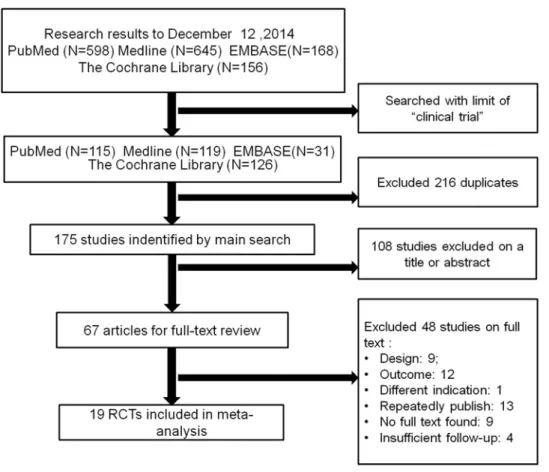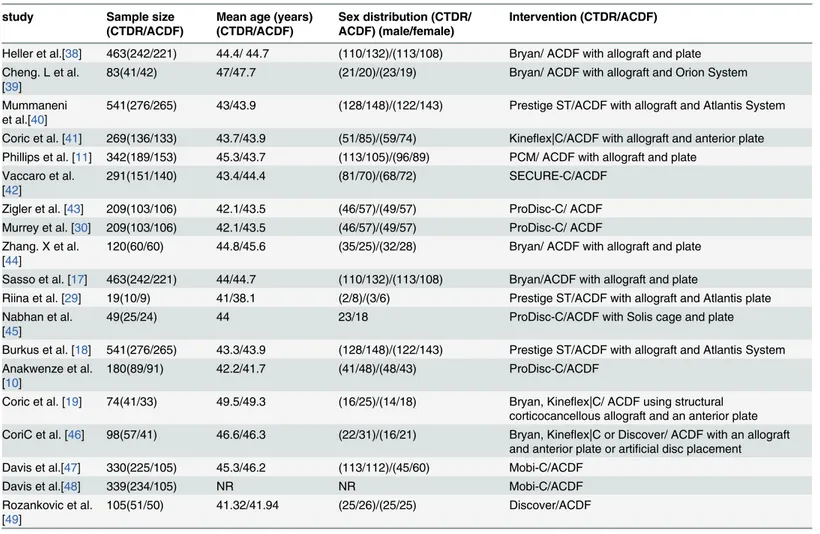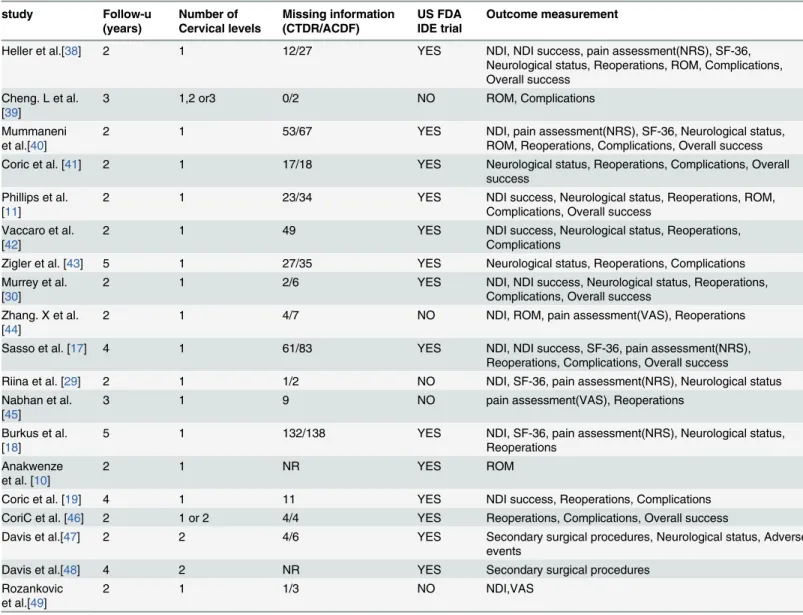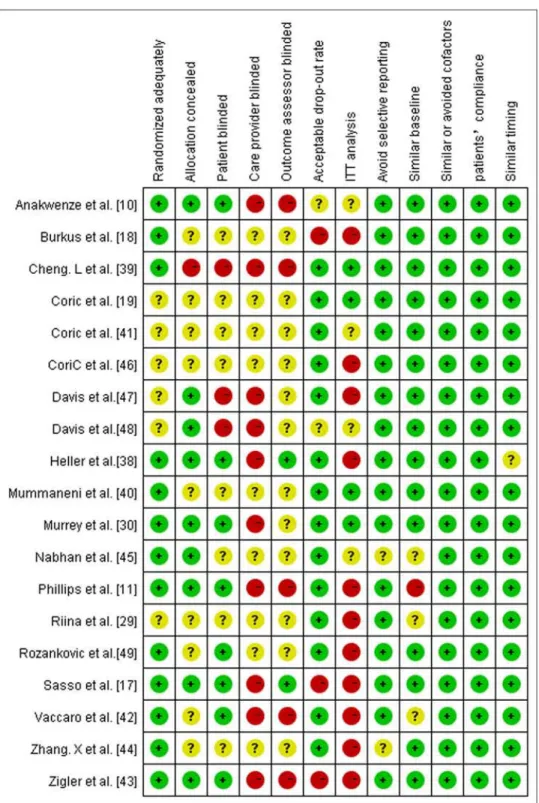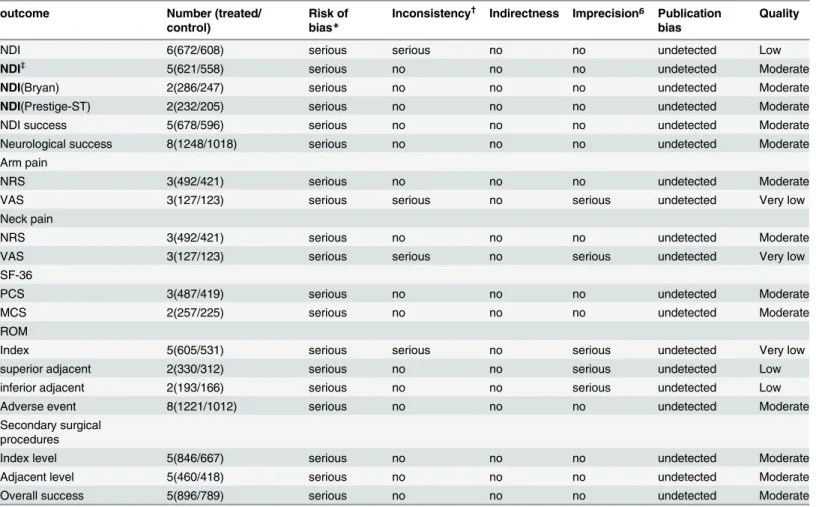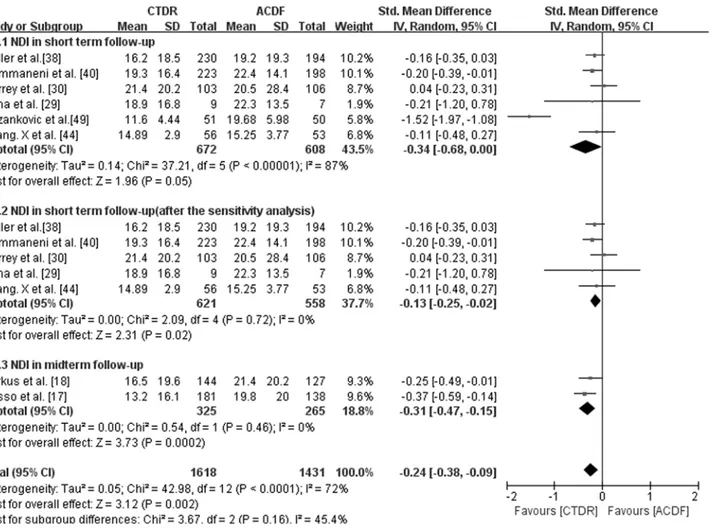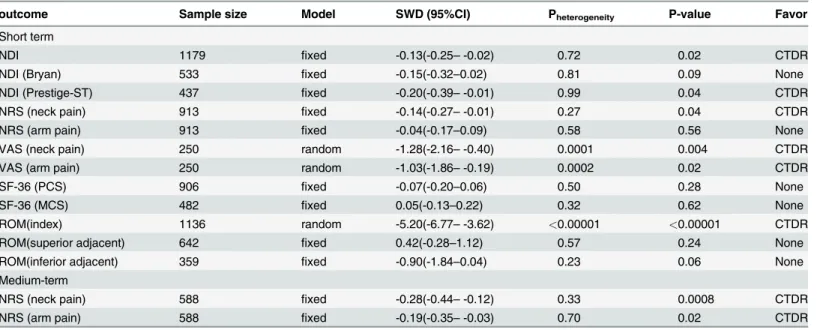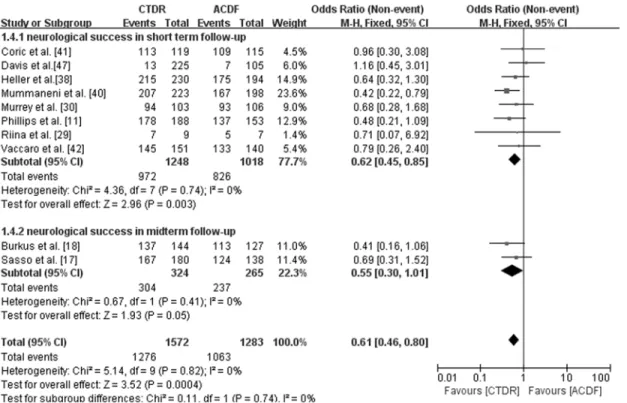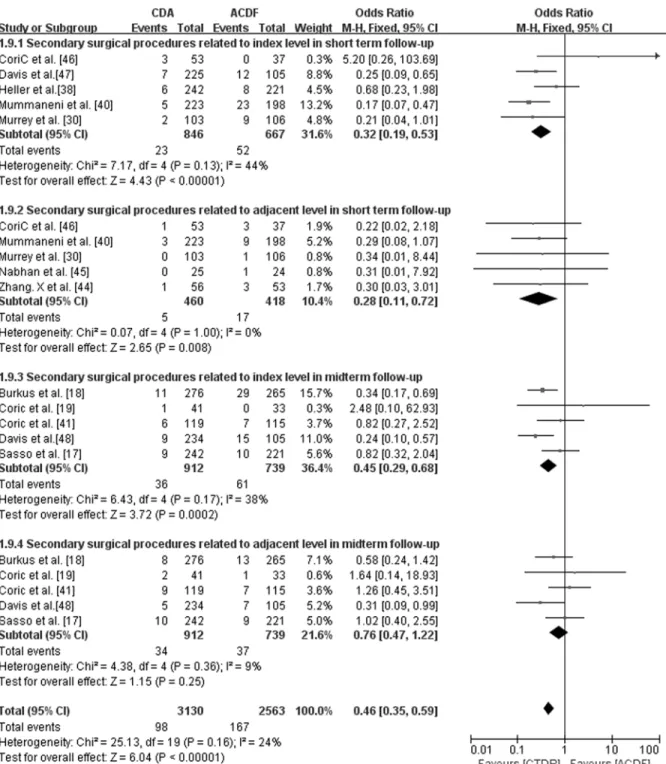Cervical Total Disc Replacement is Superior to
Anterior Cervical Decompression and Fusion:
A Meta-Analysis of Prospective Randomized
Controlled Trials
Yujie Zhang‡, Chengzhen Liang‡, Yiqing Tao, Xiaopeng Zhou, Hao Li, Fangcai Li, Qixin Chen*
Department of Orthopedic Surgery, 2nd Affiliated Hospital, School of Medicine, Zhejiang University, 88 Jie Fang Road, Hangzhou, 310009, Zhejiang, People’s Republic of China
‡These authors contributed equally to this work. *zrcqx@zju.edu.cn
Abstract
Background
Despite being considered the standard surgical procedure for symptomatic cervical disc dis-ease, anterior cervical decompression and fusion invariably accelerates adjacent segment degeneration. Cervical total disc replacement is a motion-preserving procedure developed as a substitute to fusion. Whether cervical total disc replacement is superior to fusion remains unclear.
Methods
We comprehensively searched PubMed, EMBASE, Medline, and the Cochrane Library in accordance with the inclusion criteria to identify possible studies. The retrieved results were last updated on December 12, 2014. We classified the studies as short-term and midterm follow-up.
Results
Nineteen randomized controlled trials involving 4516 cases were identified. Compared with anterior cervical decompression and fusion, cervical total disc replacement had better func-tional outcomes (neck disability index [NDI], NDI success, neurological success, neck pain scores reported on a numerical rating scale [NRS], visual analog scales scores and overall success), greater segmental motion at the index level, fewer adverse events and fewer sec-ondary surgical procedures at the index and adjacent levels in short-term follow-up (P< 0.05). With midterm follow-up, the cervical total disc replacement group indicated superiority in the NDI, neurological success, pain assessment (NRS), and secondary surgical proce-dures at the index level (P<0.05). The Short Form 36 (SF-36) and segmental motion at the adjacent level in the short-term follow-up showed no significant difference between the two OPEN ACCESS
Citation:Zhang Y, Liang C, Tao Y, Zhou X, Li H, Li F, et al. (2015) Cervical Total Disc Replacement is Superior to Anterior Cervical Decompression and Fusion: A Meta-Analysis of Prospective Randomized Controlled Trials. PLoS ONE 10(3): e0117826. doi:10.1371/journal.pone.0117826
Academic Editor:Mohammed Shamji, Toronto Western Hospital, CANADA
Received:November 15, 2014
Accepted:December 30, 2014
Published:March 30, 2015
Copyright:© 2015 Zhang et al. This is an open access article distributed under the terms of the Creative Commons Attribution License, which permits unrestricted use, distribution, and reproduction in any medium, provided the original author and source are credited.
Data Availability Statement:All relevant data are within the paper and its Supporting Information files.
Funding:This study was partly supported by a grant from the National Nature Science Foundation of China (81401822 and 81171756), and the key Science and Technology Planning Project (2012C13G2010083) and (2012C33121) and Nature Science Foundation (Q14H060007 and
procedures, as did the secondary surgical procedure rates at the adjacent level with mid-term follow-up (P>0.05).
Conclusions
Cervical total disc replacement presented favorable functional outcomes, fewer adverse events, and fewer secondary surgical procedures. The efficacy and safety of cervical total disc replacement are superior to those of fusion. Longer-term, multicenter studies are re-quired for a better evaluation of the long-term efficacy and safety of the two procedures.
Introduction
Anterior cervical decompression and fusion (ACDF) is generally considered the standard sur-gical procedure for cervical myelopathy or radiculopathy with degenerative disc disease [1,2]. ACDF typically consists of decompression, grafting and plate fixation [3]. Compared to other spinal procedures, ACDF demonstrates higher success rates, including more favorable out-comes and relief of symptoms [4]. Complications invariably occur with this procedure. Pseu-darthrosis and junctional degeneration, commonly known as adjacent segment disease, are the most notable complications, which is explained by bio-mechanical studies which indicate that adjacent levels of cervical fusion present higher intradiscal pressures and increased segmental motion [5–7]. In recent decades, data have shown that as a consequence of fusion surgery, the incidence of adjacent segment degeneration varies from 3% to 8% annually, and approximately 25% of the patients would present with clinically significant adjacent segment disease within 10 years after the initial surgery [6,8,9].
Cervical total disc replacement (CTDR) is a relatively new motion-preserving procedure that has been regarded as a substitute for ACDF [10–12]. The function of CTDR in motion preservation of the adjacent segment remains controversial. Additionally, the incidence of het-erotopic ossification and the effect on adjacent-level disease resulting from CTDR are disputed in clinical studies [13,14]. To address these issues, we collected prospective evidence and per-formed a meta-analysis to compare the efficacy and safety of CTDR and ACDF for the treat-ment of symptomatic cervical disc disease.
Materials and Methods
Search Strategy and Criteria
Two independent reviewers (YJZ and CZL) systematically searched electronic databases (PubMed, EMBASE, Medline, and the Cochrane Library) with a limit of‘‘clinical trial”. The re-trieved results were last updated on December 12, 2014. We used the following terms and Bool-ean operators:‘‘(Anterior cervical decompression and fusion OR anterior cervical arthrodesis OR ACDF OR fusion) AND (Artificial cervical disc replacement OR CTDR OR Cervical arthroplasty OR disc implants OR disc prostheses OR CDA)”. We included studies that met the following criteria: (1) the target patients had symptomatic cervical disc disease and under-went CTDR or ACDF; (2) the patients were older than 18 years; (3) postoperative follow-up ex-tended at least 2 years for the included patients; (4) the outcomes included at least one of the following conditions: 1) neck disability index (NDI); 2) NDI success; 3) neck and arm pain as-sessments measured by visual analog scales (VAS) or the numerical rating scale (NRS); 4) Short Form 36(SF-36) mental or physical health surveys (physical component summary or
mental component summary scores); 5) Neurological status; 6) flexion-extension ROM at the index and adjacent levels; 7) secondary surgical procedures; 8) adverse events; 9) overall suc-cess; (5) the trial was a randomized controlled trial (RCT). Trials were excluded according to the following criteria: (1) the articles were observational studies, case reports, or reviews; (2) the outcomes were graphic without numerical values; (3) the same data had been published previously; (4) the RCTs had a follow-up of less than 2 years.
Data Extraction
For each eligible trial, the elements of the data, including the study design, intervention proto-col, sample size, demographic data (age, gender distribution), trial duration, follow-up times, trial outcomes and loss to follow-up, were independently extracted by two reviewers (YJZ and CZL). If any disagreements existed, a third reviewer (YQT) was involved in the discussion until consensus was reached.
Quality Assessment
Two reviewers (YJZ and CZL) independently evaluated the methodological quality of the in-cluded trials in accordance with a 12-item scale recommended by the Cochrane Back Review Group [15]. If at least six of the 12 criteria, including randomization, allocation concealment, blinding (of the patients, assessors, and surgeons), similar baseline, selective reporting, loss to follow-up, patient compliance, similar timing and intention-to-treat (ITT) analysis, were met without serious flaws, the studies were rated as having‘‘low risk of bias”. Otherwise, the studies were rated as having‘‘high risk of bias”. Additionally, the GRADE (Grades of Recommenda-tion, Assessment, Development and Evaluation) approach was used to evaluate the strength of evidence [16]. Based on parameters such as study design, precision, directness, consistency and risk of bias, the quality assessment was classified as very low, low, moderate or high.
Statistical Analysis
The odds ratio (OR) and the corresponding 95% confidence interval (CI) were assessed for the dichotomous outcomes, and the standardized mean difference (SMD) and 95% CI were as-sessed for the continuous outcomes. The chi-square test and Higgin’sI2test were used to evalu-ate the heterogeneity. Apvalue less than 0.10 for the chi-square test orI2values exceeding 50% indicated substantial heterogeneity. A fixed-effect model was used if significantly statistical het-erogeneity was absent; otherwise, a random-effect model was applied. Because of the limited number of included studies, we did not assess the possibility of publishing bias. We used Re-view Manager Software (RevMan Version 5.2, The Cochrane Collaboration, Copenhagen, Denmark) to conduct the statistical analysis.
Results
Study Quality
According to the quality assessment criteria recommended by the Cochrane Back Review Group, eighteen studies with‘‘low risk of bias”and one study with‘‘high risk of bias”were found (Fig. 2). According to GRADE, a majority of the trials reviewed in our meta-analysis were moderate-quality studies (Tables3and4).
Neck Disability Index (NDI)
With short-term follow-up, the CTDR group had statistically lower NDI scores (SMD, -0.34; 95% CI: -0.68 to 0.00,P= 0.05) than the ACDF group. However, there existed a substantial het-erogeneity. Then we conducted sensitivity analysis and the result also showed that CTDR group had better NDI scores (SMD, -0.13; 95% CI: -0.25 to -0.02,P= 0.02) compared with ACDF group (Fig. 3). Additionally, we did subgroup analysis stratified by different types of prostheses. CTDR with Bryan had no significant difference compared with ACDF (SMD, -0.15; 95% CI: -0.32 to 0.02, P = 0.09). And CTDR with Prestige ST presented significantly lower NDI than ACDF (SMD, -0.20; 95% CI: -0.39 to -0.01, P = 0.04) (Table 5). With midterm follow-up, the NDI scores in the CTDR group were lower than those of the ACDF group (SMD, -0.31; 95% CI: -0.47 to -0.15,P= 0.0002) (Fig. 3).
Neck Disability Index (NDI) success
NDI success was defined as a15-point improvement in the NDI scores after surgery, which is generally regarded as a measure of function recovery [17]. Five studies with short-term
Fig 1. Flow chart for inclusion of studies.
follow-up provided NDI success data. As shown inFig. 4, the CTDR group had a statistically higher NDI success rate than the ACDF group (OR, 0.72; 95% CI: 0.54 to 0.95,P= 0.02).
Neurological success
Maintenance or improvement of each neurological parameters (motor, sensory and reflexes) in standardized neurological examinations was interpreted as neurological success [11]. With short-term follow-up, there was a statistically higher neurological success rate in the CTDR group than in the ACDF group (OR, 0.62; 95% CI: 0.45 to 0.85,P= 0.003). With midterm follow-up, two studies provided neurological success data. Additionally, we found that more patients in the CTDR group achieved neurological success than in the ACDF group (OR, 0.55; 95% CI: 0.30 to 1.01,P= 0.05) (Fig. 5).
Neck and arm pain
Neck and arm pain was measured using numerical rating scales or visual analog scales. Three studies with short-term follow up used numerical rating scales to measure neck and arm pain. Compared with the ACDF group, the CTDR group had significantly lower neck pain scores
Table 1. Characteristics of the articles included in this review. study Sample size
(CTDR/ACDF)
Mean age (years) (CTDR/ACDF)
Sex distribution (CTDR/ ACDF) (male/female)
Intervention (CTDR/ACDF)
Heller et al.[38] 463(242/221) 44.4/ 44.7 (110/132)/(113/108) Bryan/ ACDF with allograft and plate Cheng. L et al.
[39]
83(41/42) 47/47.7 (21/20)/(23/19) Bryan/ ACDF with allograft and Orion System
Mummaneni et al.[40]
541(276/265) 43/43.9 (128/148)/(122/143) Prestige ST/ACDF with allograft and Atlantis System
Coric et al. [41] 269(136/133) 43.7/43.9 (51/85)/(59/74) Kineflex|C/ACDF with allograft and anterior plate Phillips et al. [11] 342(189/153) 45.3/43.7 (113/105)/(96/89) PCM/ ACDF with allograft and plate
Vaccaro et al. [42]
291(151/140) 43.4/44.4 (81/70)/(68/72) SECURE-C/ACDF
Zigler et al. [43] 209(103/106) 42.1/43.5 (46/57)/(49/57) ProDisc-C/ ACDF Murrey et al. [30] 209(103/106) 42.1/43.5 (46/57)/(49/57) ProDisc-C/ ACDF Zhang. X et al.
[44]
120(60/60) 44.8/45.6 (35/25)/(32/28) Bryan/ ACDF with allograft and plate
Sasso et al. [17] 463(242/221) 44/44.7 (110/132)/(113/108) Bryan/ACDF with allograft and plate
Riina et al. [29] 19(10/9) 41/38.1 (2/8)/(3/6) Prestige ST/ACDF with allograft and Atlantis plate Nabhan et al.
[45]
49(25/24) 44 23/18 ProDisc-C/ACDF with Solis cage and plate
Burkus et al. [18] 541(276/265) 43.3/43.9 (128/148)/(122/143) Prestige ST/ACDF with allograft and Atlantis System Anakwenze et al.
[10]
180(89/91) 42.2/41.7 (41/48)/(48/43) ProDisc-C/ACDF
Coric et al. [19] 74(41/33) 49.5/49.3 (16/25)/(14/18) Bryan, Kineflex|C/ ACDF using structural corticocancellous allograft and an anterior plate CoriC et al. [46] 98(57/41) 46.6/46.3 (22/31)/(16/21) Bryan, Kineflex|C or Discover/ ACDF with an allograft
and anterior plate or artificial disc placement Davis et al.[47] 330(225/105) 45.3/46.2 (113/112)/(45/60) Mobi-C/ACDF
Davis et al.[48] 339(234/105) NR NR Mobi-C/ACDF
Rozankovic et al. [49]
105(51/50) 41.32/41.94 (25/26)/(25/25) Discover/ACDF
CTDR = cervical total disc replacement; ACDF = anterior cervical decompression and fusion; NR: not reported.
(SMD, -0.14; 95% CI: -0.27 to -0.01,P= 0.04). The arm pain scores did not differ significantly between the groups (SMD, -0.04; 95% CI: -0.17 to 0.09,P= 0.56). Three studies used visual an-alog scales to measure neck and arm pain. The CTDR group had significantly lower neck pain scores (SMD, -1.28; 95% CI: -2.16 to 0.40,P= 0.004) and significantly lower arm pain scores (SMD, -1.03; 95% CI: -1.86 to -0.19,P= 0.02) than the ACDF group. Two studies with mid-term follow-up used NRS scores. The CTDR group presented significantly lower neck pain scores (SMD, -0.28; 95% CI: -0.44 to -0.12,P= 0.0008) and significantly lower arm pain scores (SMD, -0.19; 95% CI: -0.35 to -0.03,P= 0.02) (Table 5).
SF-36
The SF-36 test is a self-administered questionnaire to assess general health status; it consists of a physical component summary (PCS) score and a mental component summary (MCS) score
Table 2. Characteristics and clinical outcome measurements of the articles included in this review. study Follow-u (years) Number of Cervical levels Missing information (CTDR/ACDF) US FDA IDE trial Outcome measurement
Heller et al.[38] 2 1 12/27 YES NDI, NDI success, pain assessment(NRS), SF-36,
Neurological status, Reoperations, ROM, Complications, Overall success
Cheng. L et al. [39]
3 1,2 or3 0/2 NO ROM, Complications
Mummaneni et al.[40]
2 1 53/67 YES NDI, pain assessment(NRS), SF-36, Neurological status,
ROM, Reoperations, Complications, Overall success Coric et al. [41] 2 1 17/18 YES Neurological status, Reoperations, Complications, Overall
success Phillips et al.
[11]
2 1 23/34 YES NDI success, Neurological status, Reoperations, ROM,
Complications, Overall success Vaccaro et al.
[42]
2 1 49 YES NDI success, Neurological status, Reoperations,
Complications
Zigler et al. [43] 5 1 27/35 YES Neurological status, Reoperations, Complications Murrey et al.
[30]
2 1 2/6 YES NDI, NDI success, Neurological status, Reoperations,
Complications, Overall success Zhang. X et al.
[44]
2 1 4/7 NO NDI, ROM, pain assessment(VAS), Reoperations
Sasso et al. [17] 4 1 61/83 YES NDI, NDI success, SF-36, pain assessment(NRS),
Reoperations, Complications, Overall success
Riina et al. [29] 2 1 1/2 NO NDI, SF-36, pain assessment(NRS), Neurological status
Nabhan et al. [45]
3 1 9 NO pain assessment(VAS), Reoperations
Burkus et al. [18]
5 1 132/138 YES NDI, SF-36, pain assessment(NRS), Neurological status,
Reoperations Anakwenze
et al. [10]
2 1 NR YES ROM
Coric et al. [19] 4 1 11 YES NDI success, Reoperations, Complications
CoriC et al. [46] 2 1 or 2 4/4 YES Reoperations, Complications, Overall success
Davis et al.[47] 2 2 4/6 YES Secondary surgical procedures, Neurological status, Adverse events
Davis et al.[48] 4 2 NR YES Secondary surgical procedures
Rozankovic et al.[49]
2 1 1/3 NO NDI,VAS
CTDR = cervical total disc replacement; ACDF = anterior cervical decompression and fusion; NR: not reported
[17]. Three short-term follow-up studies provided PCS scores, and two of these studies provid-ed MCS scores as well. As shown in table5, no significant differences in the PCS scores (SMD, -0.07; 95% CI: -0.20 to 0.06,P= 0.28) and MCS scores (SMD, 0.05; 95% CI: -0.13 to 0.22, P= 0.62) were observed between the CTDR group and the ACDF group.
Fig 2. The risk of bias for the included studies was assessed in our meta-analysis.
Range of Motion (ROM)
The segmental motions were calculated from the angular motion on lateral flexion and exten-sion radiographs of the cervical spine [18]. Five short-term follow-up studies provided ROM data at the index level. The CTDR group presented statistically better range of motion at the index level compared with the ACDF group (SMD, -5.20; 95% CI: -6.77 to -3.62, P<0.00001). Two short-term follow-up studies provided ROM data at the adjacent level. No
significant differences in ROM at the superior adjacent level (SMD, 0.42; 95% CI: -0.28 to 1.12, P= 0.24) or the inferior adjacent level (SMD, -0.90; 95% CI: -1.84 to 0.04,P= 0.06) were found (Table 5).
Table 3. GRADE evidence profile of RCTs for compare CTDR and ACDF in short-term follow-up. outcome Number (treated/
control)
Risk of bias*
Inconsistency† Indirectness Imprecisionᵷ Publication
bias
Quality
NDI 6(672/608) serious serious no no undetected Low
NDI‡ 5(621/558) serious no no no undetected Moderate
NDI(Bryan) 2(286/247) serious no no no undetected Moderate
NDI(Prestige-ST) 2(232/205) serious no no no undetected Moderate
NDI success 5(678/596) serious no no no undetected Moderate
Neurological success 8(1248/1018) serious no no no undetected Moderate
Arm pain
NRS 3(492/421) serious no no no undetected Moderate
VAS 3(127/123) serious serious no serious undetected Very low
Neck pain
NRS 3(492/421) serious no no no undetected Moderate
VAS 3(127/123) serious serious no serious undetected Very low
SF-36
PCS 3(487/419) serious no no no undetected Moderate
MCS 2(257/225) serious no no no undetected Moderate
ROM
Index 5(605/531) serious serious no serious undetected Very low
superior adjacent 2(330/312) serious no no serious undetected Low
inferior adjacent 2(193/166) serious no no serious undetected Low
Adverse event 8(1221/1012) serious no no no undetected Moderate
Secondary surgical procedures
Index level 5(846/667) serious no no no undetected Moderate
Adjacent level 5(460/418) serious no no no undetected Moderate
Overall success 5(896/789) serious no no no undetected Moderate
GRADE = Grading of Recommendations Assessment, Development and Evaluation; CTDR = cervical total disc replacement; ACDF = anterior cervical decompression and fusion; NDI = neck disability index; NRS = numerical rating scale; VAS = visual analogue scale; PCS = physical component score; MCS = mental component score; ROM = range of motion.
*inadequate blinding, lack of allocation concealed in some trials may increase risk of bias;
†inconsistent report of outcomes and significant heterogeneity existed across the trials, but all were well explained by the subgroup analysis;
ᵷif a study has a wide confidence interval around the estimate of the effect, or included patients less than 400, it may cause imprecision; ‡NDI after sensitivity analysis;
Adverse events
Eight studies that included a short-term follow-up investigated adverse events. We found that adverse events occurred more frequently in the ACDF group than in the CTDR group (OR, 0.58; 95% CI: 0.43 to 0.80,P= 0.0007) (Fig. 6). One study [19] with 74 patients had valid data for midterm follow-up.
Secondary surgical procedures
Secondary surgical procedures were defined as any hardware removal, revisions, supplemental fixations, and reoperations [18]. They were typically used to resolve persistent neck or shoulder pain, dysphagia, prosthesis flexibility or adjacent level degeneration. For the short-term follow-up studies, we analyzed secondary surgical procedures at the index level and the adjacent level. We found that the CTDR group had significantly fewer secondary surgical procedures at the index (OR, 0.32; 95% CI: 0.19 to 0.53, P<0.00001) and the adjacent level (OR, 0.28; 95% CI:
0.11 to 0.72, P = 0.008). For the studies with midterm follow-up, the rate of secondary surgical procedures at the adjacent level (OR, 0.76; 95% CI: 0.47 to 1.22, P = 0.25) was not significantly different between the groups. We noted significantly fewer secondary surgical procedures relat-ed to the index level in the CTDR group (OR, 0.45; 95% CI: 0.29 to 0.68, P = 0.0002) (Fig. 7).
Overall Success
If a patient achieved all of the following items, the treatment was considered an overall success: NDI success, Neurological success, an absence of serious adverse events associated with the im-plant or procedure and without a secondary surgery or intervention [17]. Serious adverse events were defined as grade 3 or 4 adverse events based on the WHO criteria [20]. Six studies provided data on the overall success, and five of those had short-term follow-ups. One study with 463 patients focused on midterm follow-up [17]. The CTDR group presented a signifi-cantly higher overall success rate in studies with short-term (OR, 0.59; 95% CI: 0.48 to 0.74, P<0.00001) and midterm follow-up (P= 0.004) (Fig. 8).
Table 4. GRADE evidence profile of RCTs for compare CTDR and ACDF in midterm follow-up. outcome Number (treated/
control)
Risk of bias*
Inconsistency† Indirectness Imprecisionᵷ Publication
bias
Quality
NDI 2(325/265) serious no no no undetected moderate
Neurological success 2(324/265) serious no no serious undetected low
NRS
Neck pain 2(323/265) serious no no no undetected moderate
Arm pain 2(323/265) serious no no no undetected moderate
Secondary surgical procedures
Index level 5(912/739) serious no no no undetected moderate
Adjacent level 5(912/739) serious no no no undetected moderate
GRADE = Grading of Recommendations Assessment, Development and Evaluation; CTDR = cervical total disc replacement; ACDF = anterior cervical decompression and fusion; NDI = neck disability index; NRS = numerical rating scale.
*inadequate blinding, lack of allocation concealed in some trials may increase risk of bias;
†inconsistent report of outcomes and significant heterogeneity existed across the trials, but all were well explained by the subgroup analysis;
ᵷif a study has a wide confidence interval around the estimate of the effect, or included patients less than 400, it may cause imprecision;
Discussion
Most clinical data have supported CTDR as a viable alternative to ACDF. Several recent reports [13,14] have indicated that CTDR is not better than fusion in relieving symptoms associated with disc degeneration in the cervical spine. The comparison between CTDR and fusion was conducted in a few meta-analyses. With a total of eight RCTs, Yu et al. [21] reported CTDR was more effective than fusion in overall success rate and overall reoperation rate. Nevertheless, due to limited number of trials and the sample size, it was impractical to draw a conclusion that the patients with CTDR had better clinical status than those with fusion. Verma et al. [22] reported no significant difference in the rate of ASD between CTDR and fusion. However, this study only used the reoperation rate, without radiographical assessments, to evaluate the rate of ASD. It also might have a bias due to lower dropout rate in the CTDR group than fusion group. The meta-analysis conducted by Yin et al. [23] reported better function and lower com-plications in the patients with CTDR compared with the patients with fusion. Our results were consistent with this study, but they did not exclude the RCTs with one year follow-up. And more stringent scores, such as overall success, were not utilized in their study. Overall, the effi-cacy and safety of CTDR procedures are still controversial. Moreover, most relevant
meta-Fig 3. Comparison of NDI scores between the cervical total disc replacement (CTDR, experimental) group and the fusion (ACDF, control) group.IV = inverse variance, CI = confidence interval, and df = degrees of freedom.
analyses [14,21–23] only chose the RCTs published before 2012, whereas several latest RCTs were reported in the last two years. We performed a meta-analysis of nineteen RCTs to deter-mine whether CTDR was superior to ACDF.
This meta-analysis showed that patients treated with CTDR had better NDI improvement and higher NDI success rates than those treated with ACDF in short-term and midterm fol-low-up. However, in the subgroup analysis of NDI, CTDR with Bryan had no significant differ-ence compared with ACDF, while CTDR with Prestige ST presented significantly lower NDI than ACDF. The result indicated that different types of prosthesis might have different efficacy
Table 5. The pooled results of meta-analysis.
outcome Sample size Model SWD (95%CI) Pheterogeneity P-value Favor
Short term
NDI 1179 fixed -0.13(-0.25–-0.02) 0.72 0.02 CTDR
NDI (Bryan) 533 fixed -0.15(-0.32–0.02) 0.81 0.09 None
NDI (Prestige-ST) 437 fixed -0.20(-0.39–-0.01) 0.99 0.04 CTDR
NRS (neck pain) 913 fixed -0.14(-0.27–-0.01) 0.27 0.04 CTDR
NRS (arm pain) 913 fixed -0.04(-0.17–0.09) 0.58 0.56 None
VAS (neck pain) 250 random -1.28(-2.16–-0.40) 0.0001 0.004 CTDR
VAS (arm pain) 250 random -1.03(-1.86–-0.19) 0.0002 0.02 CTDR
SF-36 (PCS) 906 fixed -0.07(-0.20–0.06) 0.50 0.28 None
SF-36 (MCS) 482 fixed 0.05(-0.13–0.22) 0.32 0.62 None
ROM(index) 1136 random -5.20(-6.77–-3.62) <0.00001 <0.00001 CTDR
ROM(superior adjacent) 642 fixed 0.42(-0.28–1.12) 0.57 0.24 None
ROM(inferior adjacent) 359 fixed -0.90(-1.84–0.04) 0.23 0.06 None
Medium-term
NRS (neck pain) 588 fixed -0.28(-0.44–-0.12) 0.33 0.0008 CTDR
NRS (arm pain) 588 fixed -0.19(-0.35–-0.03) 0.70 0.02 CTDR
SWD = standardized mean difference; NDI = Neck Disability Index; NRS = numerical rating scale; VAS = visual analogue scale; PCS = physical component score; MCS = mental component score; ROM = range of motion. CTDR = cervical total disc replacement; None = no statistical differences;
doi:10.1371/journal.pone.0117826.t005
Fig 4. Comparison of NDI success between the cervical total disc replacement (CTDR, experimental) group and the fusion (ACDF, control) group in short-term follow-up.MH = Mantel-Haenszel, CI = confidence interval, and df = degrees of freedom.
and safety. Due to limited number of included articles, the other outcomes cannot be per-formed subgroup analyses stratified by types of prostheses. In addition to superior NDI out-comes, higher neurological success rates were reported in the CTDR group than in the fusion group. Regarding pain relief, we found that the CTDR group had lower neck pain (NRS) scores
Fig 5. Comparison of Neurological success between the cervical total disc replacement (CTDR, experimental) group and the fusion (ACDF, control) group.MH = Mantel-Haenszel, CI = confidence interval, and df = degrees of freedom.
doi:10.1371/journal.pone.0117826.g005
Fig 6. Comparison of Adverse events between the cervical total disc replacement (CTDR, experimental) group and the fusion (ACDF, control) group in short-term follow-up.MH = Mantel-Haenszel, CI = confidence interval, and df = degrees of freedom.
in short-term follow-up and lower neck and arm pain (NRS) scores in the midterm follow-up. Additionally, the neck and arm pain (VAS) scores in short-term follow-up also demonstrated the CTDR group had a favorable outcome. Overall, the CTDR group showed better functional improvement than the fusion group.
Fig 7. Comparison of Secondary surgical procedures between the cervical total disc replacement (CTDR, experimental) group and the fusion (ACDF, control) group.MH = Mantel-Haenszel, CI = confidence interval, and df = degrees of freedom.
Compared with fusion, CTDR resulted in better segmental motion at the index level, which was consistent with the results of previous studies [24,25]. As demonstrated in previous studies, impaired ROM at the index level was normally in compensation at the adjacent levels in spinal procedures. Worse segmental motion at the index level would result in a higher load and intra-discal pressure on the adjacent segments, which would accelerate the degeneration of the adja-cent segments. Eck JC et al. [7] explained that high intradiscal pressure led to an accumulation of waste products in the disc, which could cause cell death and disrupt metabolism. To avoid detrimental non-physiological loading exertion on the adjacent segments, researchers have fo-cused their attention on developing CTDR to maintain the basic motion of intervertebral seg-ments [26]. The assumption that adjacent segment disease arises from spinal fusion with iatrogenic motion restriction is under debate. Some investigators have hypothesized that adja-cent segment disease signifies progression of the natural history of spinal segmental degenera-tion [26,27]. The pooled results of this analysis indicated that although CTDR could retain segmental motion at the index level more effectively than fusion, the ROMs at the superior adja-cent and inferior adjaadja-cent level were not statistically different. On the other hand, our data indi-cated that the CTDR group had significantly fewer secondary surgical procedures attributable to adjacent segment degeneration in the short-term follow-up. Hence, we hypothesized that some other factors influenced the incidence of adjacent segment degeneration. Nunley and colleagues [26] considered that bone mineral density and presence of concurrent lumbar degeneration had a significant effect in the incidence of adjacent segment degeneration.
In addition to fewer secondary surgical procedures, the CTDR group also had fewer adverse events. The most frequent adverse events of CTDR include heterotopic ossification, segmental kyphosis, migration, or subsidence of the artificial disc. Previous generations of CTDR were typically associated with high adverse events rates. For instance, the Bristol–Cummins joint was very efficient in maintaining motion; however, it is always complicated by joint subluxa-tion, screw failure and high rates of dysphagia [28]. As technology has progressed, increasing numbers of new models have been developed, including the Bryan, Prestige ST, and ProDisc-C. The Bryan prosthesis consists of a polyurethane nucleus in a saline solution bath sand-wiched between two titanium alloy surfaces. And the device allows for bone ingrowth from the vertebral end plates [17]. The Prestige ST prosthesis is a dynamic stainless steel device that con-sists of two metal plates, and the device permits segmental spinal motion through a ball-and-trough mechanism and maintains disc space height [29]. The ProDisc-C prosthesis is com-posed of two cobalt chromium molybdenum alloy end plates with midline keels and an
Fig 8. Comparison of overall success between the cervical total disc replacement (CTDR, experimental) group and the fusion (ACDF, control) group in short-term follow-up.MH = Mantel-Haenszel, CI = confidence interval, and df = degrees of freedom.
ultrahigh–molecular weight polyethylene (UHMWPE) inlay. The midline keel on the vertebral surfaces provides fixation while a plasma-spray titanium coating encourages bony on-growth for longer term stability [30]. Those prostheses have advantages over previous models in re-taining segmental motion, disc height and lordosis. Additionally, they have longer-term dura-bility and produce less inflammatory reaction or osteolysis. Therefore, they can better mimic a natural intervertebral disc and, consequently, can obtain better clinical outcomes with fewer prosthesis-related complications [12]. For fusion surgery, the most frequent adverse events in-clude dysphagia, dural injury, hoarseness, worsening of neurological symptoms, and graft ex-trusion. Dysphagia was reported to be the most common complication, occurring in 3.3% of patients, whereas the overall ACDF-related complication rate was 8.4% [5]. CTDR could sub-stantially decrease the incidence of dysphagia to a greater degree than fusion because the CTDR procedure demands less esophageal retraction and consequently reduces the intraeso-phageal pressure [31].
Overall success is measured by a composite score that includes NDI success, neurological status, adverse events, and subsequent surgery. The composite definition of success was signifi-cantly more stringent than the traditional definition because the procedure would be consid-ered a failure even if a patient failed only one component [32]. In this meta-analysis, the CTDR group had a higher overall success rate than the fusion group. We hypothesized that the unique advantages of the prostheses might explain the better overall success in the CTDR group than in the ACDF group. Additional effort is required to develop novel prostheses that mimic natu-ral intervertebnatu-ral discs more closely. Innovative 3D-printing technology may provide a possible solution for this issue [33–35].
Recently, several non-RCTs were published to evaluate the long-term efficacy and safety of CTDR. Malham et al. [36] reported CTDR had a pretty good improvement in functional out-comes, as well as 37% of heterotopic ossification and 21% of radiographic adjacent segment disease, with average follow-up of 7.7 years. Zhang et al. [37] also reported CTDR had satisfac-tory functional outcomes without any significant complication. In this study, mean ROM at index levels is 8.6°±0.2°and 81.3% of the segments were mobile at 6 years, which indicated that ROM was preserved at index levels. In a word, the long-term studies displayed favorable effica-cy and safety of CTDR, which was consistent with our meta-analysis.
The validity of the study results was limited by several factors. First, several studies pre-sented low quality evidence resulting from inadequate blinding, insufficient allocation conceal-ment, and imprecision. Second, missing information such as the absence of ITT analysis and loss to follow-up led to incomplete data and potentially biased results. Third, a non-inferiority study design was utilized in almost all the RCTs, and this design is typically less stringent in demonstrating efficacy than standard clinical trials. Fourth, we did not assess publication bias because of the small sample sizes, which led to imprecision across the studies. Fifth, no data on long-term efficacy and safety were available because the follow-up was no more than five years in all the included studies.
This meta-analysis indicated that in efficacy and safety, CTDR was superior to ACDF. Longer-term, multicenter studies are required for a better evaluation of the long-term efficacy and safety of these two procedures.
Supporting Information
S1 Table. Excluded Papers. (DOCX)Author Contributions
Conceived and designed the experiments: QXC YJZ. Performed the experiments: YJZ CZL YQT. Analyzed the data: YJZ CZL. Contributed reagents/materials/analysis tools: HL XPZ FCL. Wrote the paper: YJZ.
References
1. Rao RD, Currier BL, Albert TJ, Bono CM, Marawar SV, et al. (2007) Degenerative cervical spondylosis: clinical syndromes, pathogenesis, and management. J Bone Joint Surg Am 89: 1360–1378. PMID: 17575617
2. Buchowski JM, Anderson PA, Sekhon L, Riew KD (2009) Cervical disc arthroplasty compared with arthrodesis for the treatment of myelopathy. Surgical technique. J Bone Joint Surg Am 91 Suppl 2: 223–232.
3. Delamarter RB, Zigler J (2013) Five-year reoperation rates, cervical total disc replacement versus fu-sion, results of a prospective randomized clinical trial. Spine (Phila Pa 1976) 38: 711–717.
4. Palit M, Schofferman J, Goldthwaite N, Reynolds J, Kerner M, et al. (1999) Anterior discectomy and fu-sion for the management of neck pain. Spine (Phila Pa 1976) 24: 2224–2228. PMID:10562988
5. Nanda A, Sharma M, Sonig A, Ambekar S, Bollam P (2013) Surgical Complications of Anterior Cervical Diskectomy and Fusion for Cervical Degenerative Disk Disease: A Single Surgeon’s Experience of 1576 Patients. World Neurosurg.
6. Hilibrand AS, Carlson GD, Palumbo MA, Jones PK, Bohlman HH (1999) Radiculopathy and myelopa-thy at segments adjacent to the site of a previous anterior cervical arthrodesis. Journal of Bone and Joint Surgery-American Volume 81A: 519–528.
7. Eck JC, Humphreys SC, Lim TH, Jeong ST, Kim JG, et al. (2002) Biomechanical study on the effect of cervical spine fusion on adjacent-level intradiscal pressure and segmental motion. Spine (Phila Pa 1976) 27: 2431–2434. PMID:12435970
8. Yue WM, Brodner W, Highland TR (2005) Long-term results after anterior cervical discectomy and fu-sion with allograft and plating: a 5- to 11-year radiologic and clinical follow-up study. Spine (Phila Pa 1976) 30: 2138–2144.
9. Robertson JT, Papadopoulos SM, Traynelis VC (2005) Assessment of adjacent-segment disease in patients treated with cervical fusion or arthroplasty: a prospective 2-year study. Journal of Neurosur-gery-Spine 3: 417–423. PMID:16381202
10. Anakwenze OA, Auerbach JD, Milby AH, Lonner BS, Balderston RA (2009) Sagittal cervical alignment after cervical disc arthroplasty and anterior cervical discectomy and fusion: results of a prospective, ran-domized, controlled trial. Spine (Phila Pa 1976) 34: 2001–2007.
11. Phillips FM, Lee JY, Geisler FH, Cappuccino A, Chaput CD, et al. (2013) A prospective, randomized, controlled clinical investigation comparing PCM cervical disc arthroplasty with anterior cervical discect-omy and fusion. 2-year results from the US FDA IDE clinical trial. Spine (Phila Pa 1976) 38: E907–918.
12. Cason GW, Herkowitz HN (2013) Cervical Intervertebral Disc Replacement. Journal of Bone and Joint Surgery-American Volume 95A: 279–285.
13. Bartels RHMA, Donk R, Verbeek ALM (2010) No Justification for Cervical Disk Prostheses in Clinical Practice: A Meta-Analysis of Randomized Controlled Trials. Neurosurgery 66: 1153–1160. doi:10. 1227/01.NEU.0000369189.09182.5FPMID:20421840
14. Zechmeister I, Winkler R, Mad P (2011) Artificial total disc replacement versus fusion for the cervical spine: a systematic review. European Spine Journal 20: 177–184. doi:10.1007/s00586-010-1583-7 PMID:20936484
15. Furlan AD, Pennick V, Bombardier C, van Tulder M, Editorial Board CBRG (2009) 2009 updated meth-od guidelines for systematic reviews in the Cochrane Back Review Group. Spine (Phila Pa 1976) 34: 1929–1941.
16. Atkins D, Briss PA, Eccles M, Flottorp S, Guyatt GH, et al. (2005) Systems for grading the quality of evi-dence and the strength of recommendations II: pilot study of a new system. BMC Health Serv Res 5: 25. PMID:15788089
17. Sasso RC, Anderson PA, Riew KD, Heller JG (2011) Results of cervical arthroplasty compared with an-terior discectomy and fusion: four-year clinical outcomes in a prospective, randomized controlled trial. J Bone Joint Surg Am 93: 1684–1692. doi:10.2106/JBJS.J.00476PMID:21938372
controlled clinical trial. J Neurosurg Spine 13: 308–318. doi:10.3171/2010.3.SPINE09513PMID: 20809722
19. Coric D, Kim PK, Clemente JD, Boltes MO, Nussbaum M, et al. (2013) Prospective randomized study of cervical arthroplasty and anterior cervical discectomy and fusion with long-term follow-up: results in 74 patients from a single site. J Neurosurg Spine 18: 36–42. doi:10.3171/2012.9.SPINE12555PMID: 23140129
20. World Health Organization. (1979) WHO handbook for reporting results of cancer treatment. Geneva Albany, N.Y.: World Health Organization; sold by WHO Publications Centre USA. 45 p. p.
21. Yu L, Song Y, Yang X, Lv C (2011) Systematic review and meta-analysis of randomized controlled tri-als: comparison of total disk replacement with anterior cervical decompression and fusion. Orthopedics 34: e651–658. doi:10.3928/01477447-20110826-09PMID:21956061
22. Verma K, Gandhi SD, Maltenfort M, Albert TJ, Hilibrand AS, et al. (2013) Rate of adjacent segment dis-ease in cervical disc arthroplasty versus single-level fusion: meta-analysis of prospective studies. Spine (Phila Pa 1976) 38: 2253–2257.
23. Yin S, Yu X, Zhou SL, Yin ZH, Qiu YS (2013) Is Cervical Disc Arthroplasty Superior to Fusion for Treat-ment of Symptomatic Cervical Disc Disease? A Meta-Analysis. Clinical Orthopaedics and Related Re-search 471: 1904–1919. doi:10.1007/s11999-013-2830-0PMID:23389804
24. Gao Y, Liu M, Li T, Huang F, Tang T, et al. (2013) A meta-analysis comparing the results of cervical disc arthroplasty with anterior cervical discectomy and fusion (ACDF) for the treatment of symptomatic cervical disc disease. J Bone Joint Surg Am 95: 555–561. doi:10.2106/JBJS.K.00599PMID: 23515991
25. Virk SS, Niedermeier S, Yu E, Khan SN (2014) Adjacent segment disease. Orthopedics 37: 547–555. doi:10.3928/01477447-20140728-08PMID:25102498
26. Nunley PD, Jawahar A, Kerr EJ, Gordon CJ, Cavanaugh DA, et al. (2012) Factors Affecting the Inci-dence of Symptomatic Adjacent-Level Disease in Cervical Spine After Total Disc Arthroplasty 2- to 4-Year Follow-up of 3 Prospective Randomized Trials. Spine 37: 445–451. doi:10.1097/BRS. 0b013e31822174b3PMID:21587111
27. Hilibrand AS, Robbins M (2004) Adjacent segment degeneration and adjacent segment disease: the consequences of spinal fusion? Spine J 4: 190S–194S. PMID:15541666
28. Pickett GE, Sekhon LH, Sears WR, Duggal N (2006) Complications with cervical arthroplasty. J Neuro-surg Spine 4: 98–105. PMID:16506475
29. Riina J, Patel A, Dietz JW, Hoskins JS, Trammell TR, et al. (2008) Comparison of single-level cervical fu-sion and a metal-on-metal cervical disc replacement device. Am J Orthop (Belle Mead NJ) 37: E71–77.
30. Murrey D, Janssen M, Delamarter R, Goldstein J, Zigler J, et al. (2009) Results of the prospective, ran-domized, controlled multicenter Food and Drug Administration investigational device exemption study of the ProDisc-C total disc replacement versus anterior discectomy and fusion for the treatment of 1-level symptomatic cervical disc disease. Spine J 9: 275–286. doi:10.1016/j.spinee.2008.05.006PMID: 18774751
31. McAfee PC, Cappuccino A, Cunningham BW, Devine JG, Phillips FM, et al. (2010) Lower incidence of dysphagia with cervical arthroplasty compared with ACDF in a prospective randomized clinical trial. J Spinal Disord Tech 23: 1–8. doi:10.1097/BSD.0b013e31819e2ab8PMID:20051917
32. McAfee PC, Reah C, Gilder K, Eisermann L, Cunningham B (2012) A meta-analysis of comparative outcomes following cervical arthroplasty or anterior cervical fusion: results from 4 prospective multicen-ter randomized clinical trials and up to 1226 patients. Spine (Phila Pa 1976) 37: 943–952.
33. Villar G, Graham AD, Bayley H (2013) A tissue-like printed material. Science 340: 48–52. doi:10.1126/ science.1229495PMID:23559243
34. Murphy SV, Atala A (2014) 3D bioprinting of tissues and organs. Nat Biotechnol 32: 773–785. doi:10. 1038/nbt.2958PMID:25093879
35. Grunert P, Gebhard HH, Bowles RD, James AR, Potter HG, et al. (2014) Tissue-engineered interverte-bral discs: MRI results and histology in the rodent spine. J Neurosurg Spine 20: 443–451. doi:10.3171/ 2013.12.SPINE13112PMID:24527831
36. Malham GM, Parker RM, Ellis NJ, Chan PG, Varma D (2014) Cervical artificial disc replacement with ProDisc-C: clinical and radiographic outcomes with long-term follow-up. J Clin Neurosci 21: 949–953. doi:10.1016/j.jocn.2013.09.013PMID:24417795
37. Zhang Z, Zhu W, Zhu L, Du Y (2014) Midterm outcomes of total cervical total disc replacement with Bryan prosthesis. Eur J Orthop Surg Traumatol 24 Suppl 1: S275–281.
39. Cheng L, Nie L, Li M, Huo Y, Pan X (2011) Superiority of the Bryan((R)) disc prosthesis for cervical mye-lopathy: a randomized study with 3-year followup. Clin Orthop Relat Res 469: 3408–3414. doi:10. 1007/s11999-011-2039-zPMID:21997779
40. Mummaneni PV, Burkus JK, Haid RW, Traynelis VC, Zdeblick TA (2007) Clinical and radiographic anal-ysis of cervical disc arthroplasty compared with allograft fusion: a randomized controlled clinical trial. J Neurosurg Spine 6: 198–209. PMID:17355018
41. Coric D, Nunley PD, Guyer RD, Musante D, Carmody CN, et al. (2012) Prospective, randomized, multi-center study of cervical arthroplasty: 269 patients from the Kineflex|C artificial disc investigational de-vice exemption study with a minimum 2-year follow-up: clinical article. Journal of neurosurgery Spine. pp. 348–358. doi:10.3171/2012.6.SPINE11867PMID:22881039
42. Vaccaro A, Beutler W, Peppelman W, Marzluff JM, Highsmith J, et al. (2013) Clinical outcomes with se-lectively constrained SECURE-C cervical disc arthroplasty: two-year results from a prospective, ran-domized, controlled, multicenter investigational device exemption study. Spine (Phila Pa 1976) 38: 2227–2239.
43. Zigler JE, Delamarter R, Murrey D, Spivak J, Janssen M (2013) ProDisc-C and anterior cervical discect-omy and fusion as surgical treatment for single-level cervical symptomatic degenerative disc disease: five-year results of a Food and Drug Administration study. Spine (Phila Pa 1976) 38: 203–209.
44. Zhang X, Zhang X, Chen C, Zhang Y, Wang Z, et al. (2012) Randomized, controlled, multicenter, clini-cal trial comparing BRYAN cerviclini-cal disc arthroplasty with anterior cerviclini-cal decompression and fusion in China. Spine (Phila Pa 1976) 37: 433–438.
45. Nabhan A, Steudel WI, Nabhan A, Pape D, Ishak B (2007) Segmental kinematics and adjacent level degeneration following disc replacement versus fusion: RCT with three years of follow-up. J Long Term Eff Med Implants 17: 229–236. PMID:19023947
46. Coric D, Cassis J, Carew JD, Boltes MO (2010) Prospective study of cervical arthroplasty in 98 patients involved in 1 of 3 separate investigational device exemption studies from a single investigational site with a minimum 2-year follow-up. Clinical article. J Neurosurg Spine 13: 715–721. doi:10.3171/2010.5. SPINE09852PMID:21121748
47. Davis RJ, Kim KD, Hisey MS, Hoffman GA, Bae HW, et al. (2013) Cervical total disc replacement with the Mobi-C cervical artificial disc compared with anterior discectomy and fusion for treatment of 2-level symptomatic degenerative disc disease: a prospective, randomized, controlled multicenter clinical trial: clinical article. J Neurosurg Spine 19: 532–545. doi:10.3171/2013.6.SPINE12527PMID:24010901
48. Davis RJ, Hoffman GA, Bae HW, Hisey MS, Rashbaum RF, et al. (2013) Cervical disc arthroplasty re-sults in fewer secondary surgeries through 48 months compared to ACDF: Rere-sults for a prospective randomized IDE study for two-level use. Spine Journal 13: 164S–165S.
